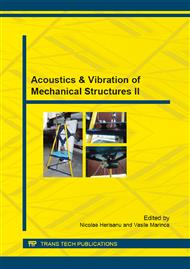[1]
Bratu, P., Alexandru, C., Vasile, O., The evaluation of the isolation degree of buildings supported on elastomeric devices at seismic shocks (2014) 21st International Congress on Sound and Vibration 2014, ICSV 2014, 1, pp.608-615.
Google Scholar
[2]
Bratu, P., Evaluation of the dissipated energy in viscoelastic or hysteretic seismic isolators, (2012) Romanian Journal of Acoustics and Vibration, 9 (1), pp.53-56.
Google Scholar
[3]
Bratu, P., Vasile, O., Assessment of dissipated energy to harmonic cycles of displacement for visco-elastic elastomeric anti-seismic insulators, (2012) Romanian Journal of Acoustics and Vibration, 9 (2), pp.83-89.
Google Scholar
[4]
Alexandru, C., Rheological models of the vibration isolation systems in the case of elastomeric materials, (2014) 21st International Congress on Sound and Vibration 2014, ICSV 2014, 1, pp.589-595.
Google Scholar
[5]
Alexandru, C., Evaluation of internal dissipated energy for anti-vibration elastomeric isolators, (2013) 20th International Congress on Sound and Vibration 2013, ICSV 2013, 2, pp.1325-1331.
Google Scholar
[6]
Polidor, B., Carmen, A., Comparative analysis of dynamic response of an elastic-dissipative system with Voigt-Kelvin or Maxwell rheological behavior, (2013) 20th International Congress on Sound and Vibration 2013, ICSV 2013, 3, p.1903-(1907).
Google Scholar
[7]
M. Ciuncanu , The influence of the excitation signal form on the evaluation of the damping characterics of the elestomeric antiseismic isolators, Bucuresti, SISOM 30-31 mai (2013).
Google Scholar
[8]
M. Ciuncanu, The control of the dynamic response for the neoprene anti-vibration isolators tests to inertial vibratory excitation with eccentric masses, Multi-Conference on Systems & Structures (SysStruc 13), Resita-Analele Universitatii "Eftimie Murgu, Reşiţa, Fascicula de Inginerie, Anul XX, Nr. 2, (2013).
Google Scholar
[9]
R. Pintoi, Dependence of the Concrete Strength on the Duration of the Compaction by Vibration Process, Romanian Journal of Acoustics and Vibrations, RJAV, vol. XI, issue 1/2014, pg. 67-70.
Google Scholar
[10]
Knabel, M., Jager, H., Mastel, R., Technische Schwingungslere. 7 Auflage. Studium Vieweg. Teubner/ GWV Fachverlage GmbH, Wiesbaden (2009).
Google Scholar


